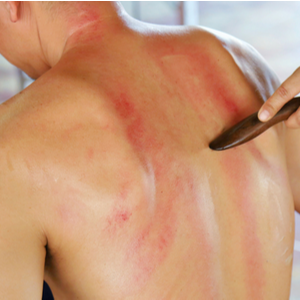Quick Links

Thick areas of skin with a smooth shiny appearance are a defining feature of scleroderma. This is a group of connective tissue disorders that cause thickening and hardening of the skin (a process known as a fibrosis). Blood vessels can also become damaged and the body is unable to repair them. Scleroderma usually starts with a few dry patches of skin on the hands or face that then become thicker and harder. These patches then spread to other areas of the skin.
When scleroderma involves just the skin and soft tissue beneath, it is said to be “localized”. When the connective tissue inside our bodies is also disrupted, the condition is termed “systemic”. This more severe form of the condition upsets the ability of our body’s internal organs to function. Scleroderma is not contagious or cancerous, but it can be hereditary.
Scleroderma Symptoms
There are four main sub-types of scleroderma, ordered in terms of increasing severity of symptoms:
- Morphea – patches of localized scleroderma can appear anywhere on the skin, but commonly show up on the trunk.
- Scleroderma linear – as the name suggests, hardened skin appears in lines, usually on the arms or legs. This localized scleroderma tightens the skin and can restrict movement. In children this tightening can upset long bone growth and needs to be closely watched.
- Limited systemic sclerosis (also known as CREST syndrome) – This usually affects the face, hands, forearm, feet and lower leg. It is often associated with Raynaud’s disease which restricts blood circulation in the fingertips and toes making them feel cold and numb. Internally, the heart and digestive system may also be damaged, causing heartburn and difficulty in swallowing.
- Diffuse scleroderma/systemic sclerosis – this is a more widespread condition upsetting more of the body than the limited systemic form. Lungs, kidneys, muscles and joints can also be damaged. Muscle pain, joint stiffness and fatigue are not uncommon.
Scleroderma Treatment
Scleroderma is one of the more serious autoimmune disorders, so it is important to consult a skin expert to determine the type and extent of your condition. While there is no cure for scleroderma, the skin experts at Trillium Creek Dermatology can provide a number of medications to manage the symptoms of the disease.
In addition, Trillium Creek Dermatology offers the latest in laser treatments to minimize or eliminate the appearance of damaged blood vessels and lesions that are caused by scleroderma. We are serving the following communities and those surrounding: Wooster, Wadsworth, Medina, Brunswick, Strongsville, and Hinkley.


